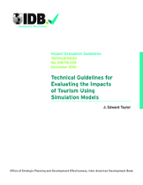Technical Guidelines for Evaluating the Impacts of Tourism Using Simulation Models
Date
Dec 2010
The purpose of this guideline is to make practitioners aware of simulation approaches for the evaluation of tourism projects. Simulation approaches are particularly useful when experimental or economic approaches for project evaluation are not feasible. For example, it usually is not possible to roll out a tourism-promotion program for a randomly chosen "treatment group" while excluding the program's benefits for a "control group" at the tourist destination. The guideline explains why a simulation approach is useful for tourism impact analysis, what a simulation model for the economic analysis of tourism impacts looks like, and data requirements. With the help of an illustrative two-island model, the guideline shows how to construct different kinds of simulation models and how to use simulations to quantify the costs and benefits of tourism and tourism projects. The guideline concludes by discussing some specific IDB projects in which this methodology has been used for tourism impact analysis. The primary goal of this paper is to make development practitioners aware of simulation approaches for tourism impact analysis and of how to integrate these approaches into their project proposals, budgets, and terms of reference for expert consultants.



